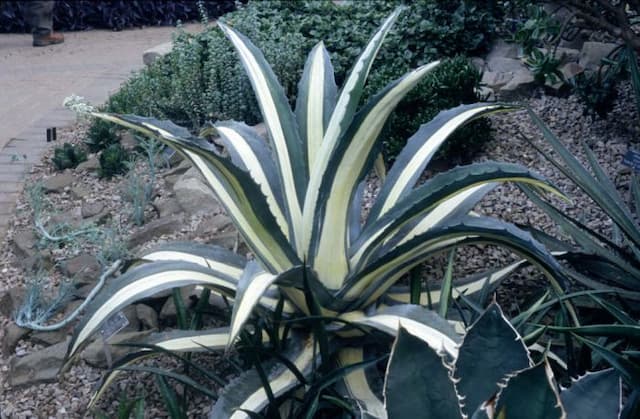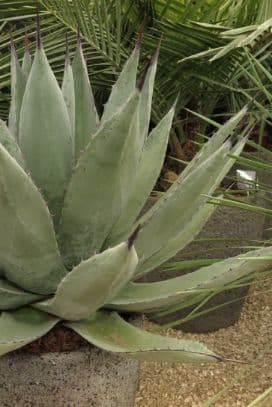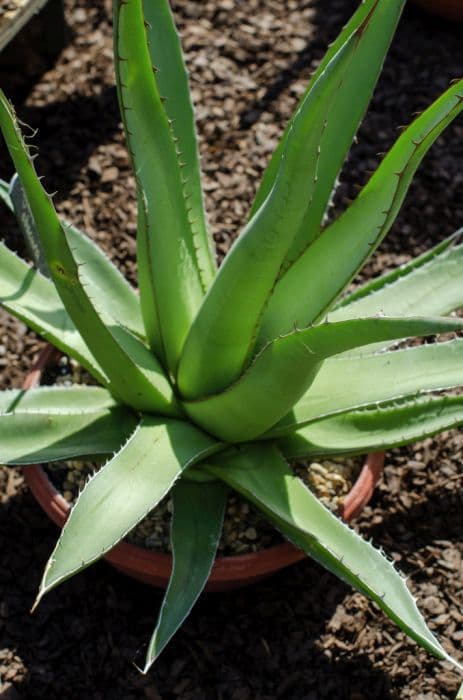Pineapple lily Eucomis pallidiflora

ABOUT
Eucomis pallidiflora, commonly known as the giant pineapple lily, is a distinctive perennial characterized by its unique flower structure. The plant features a rosette of strap-like leaves, which are usually a lush green color. These leaves form a dense basal cluster from which the central flower spike emerges during the blooming season. The spike is topped with a tuft of smaller bract-like leaves that somewhat resemble a pineapple's crown, which is how the plant got its common name. The main flower spike hosts numerous small, star-shaped flowers. These blooms are typically a soft, creamy color, often with hints of green or yellow. Each individual flower is composed of six distinct petals surrounding a central cluster of reproductive parts that may be yellowish or pale in color. After flowering, the plant produces capsule-like fruits that eventually dry and release seeds. In summary, the giant pineapple lily stands out for its striking pineapple-like flower spike and rosette of strap-like leaves, all contributing to the visual appeal that makes it a favorite in ornamental gardens.
About this plant
 Names
NamesSynonyms
Giant Pineapple Lily, Pale Pineapple Lily
Common names
Eucomis pallidiflora subsp. pole-evansii, Eucomis undulata.
 Toxicity
ToxicityTo humans
Eucomis pallidiflora, commonly known as pineapple lily, is not typically known for being highly toxic to humans. However, as with many plants, it could cause mild stomach upset if ingested. The symptoms of such ingestion may include nausea, vomiting, and diarrhea. It's important to note that individual reactions to plant ingestion can vary, and it's advisable to avoid consuming any part of the pineapple lily.
To pets
Pineapple lily (Eucomis pallidiflora) is also not known to be severely toxic to pets, but ingestion could result in similar symptoms of gastrointestinal disturbance as seen in humans. If your pet consumes parts of pineapple lily, they may experience vomiting, diarrhea, or drooling. While the toxicity is generally considered mild, if you suspect your pet has ingested this plant, it is important to monitor them closely for any adverse effects and consult with a veterinarian if any concerning symptoms develop.
 Characteristics
CharacteristicsLife cycle
Perennials
Foliage type
Deciduous
Color of leaves
Green
Flower color
Cream
Height
2 feet [60 cm]
Spread
1 foot [30 cm]
Plant type
Bulb
Hardiness zones
8
Native area
South Africa
Benefits
 General Benefits
General Benefits- Aesthetic Appeal: Eucomis pallidiflora, commonly known as the Pineapple Lily, is known for its unique flower spike that resembles a pineapple, adding a distinctive and exotic touch to gardens.
- Pollinator Attraction: The blooms of the Pineapple Lily attract bees, butterflies, and other beneficial insects, supporting local ecosystems and pollination.
- Low Maintenance: Pineapple Lily is relatively easy to care for, being drought-tolerant and requiring minimal maintenance once established.
- Drought Resistance: Its ability to withstand dry conditions makes it ideal for xeriscaping and in gardens where water conservation is a priority.
- Long Blooming Period: The Pineapple Lily offers a long flowering period, usually in the summer, providing a lengthy display of its unique blooms.
- Versatility in the Garden: It can be used in a variety of garden settings, from borders to container gardens, adding versatility to landscaping projects.
- Foliage Interest: Even when not in bloom, the rosette of strap-like leaves adds a lush, green presence to the garden space.
- Easy Propagation: The plant can be easily propagated through offsets or seed, allowing gardeners to expand their collection or share with others.
- Resilience to Pests: Pineapple Lily is not commonly afflicted by serious pest problems, making it a robust addition to the garden.
 Medical Properties
Medical PropertiesThis plant is not used for medical purposes.
 Air-purifying Qualities
Air-purifying QualitiesThis plant is not specifically known for air purifying qualities.
 Other Uses
Other Uses- Pineapple Lily bulbs can be used for natural dye creation, providing a range of colors depending on the mordant used.
- As a water-efficient plant, Pineapple Lily is ideal for xeriscaping and requires minimal watering once established.
- The robust structure of Pineapple Lily flower stems makes them valuable in the production of natural paper or eco-friendly textiles.
- Creative gardeners use dried Pineapple Lily flowers to construct intricate floral arrangements or decorative wreaths.
- The Pineapple Lily's foliage can be used as a background plant in mixed flower borders due to its broad and attractive leaves.
- The striking appearance of Pineapple Lily flowers can be a source of botanical illustration or photography projects.
- Dried seed pods of the Pineapple Lily can be incorporated into potpourri or as unique elements in crafting projects.
- Pineapple Lily is sometimes planted near vegetable gardens to add ornamental diversity and attract pollinators to aid in vegetable plant pollination.
- Due to its tall flower spikes, the Pineapple Lily can be planted to provide a height contrast with low-growing plants in rock gardens or alpine displays.
- Garden designers often use the architectural form of Pineapple Lily to create focal points in contemporary garden layouts.
Interesting Facts
 Feng Shui
Feng ShuiThe pineapple lily is not used in Feng Shui practice.
 Zodiac Sign Compitability
Zodiac Sign CompitabilityThe pineapple lily is not used in astrology practice.
 Plant Symbolism
Plant Symbolism- Exotic Beauty: Pineapple Lily, as Eucomis pallidiflora is commonly known, resembles a tropical pineapple with its unique flower spike and rosette of leaves beneath, representing striking and exotic beauty in the plant world.
- Uniqueness and Individuality: Because the Pineapple Lily is quite distinctive in its appearance when compared with more common flowers, it often symbolizes standing out from the crowd or celebrating one's individuality.
- Eccentricity: The plant's unusual look gives it an eccentric appeal, symbolizing the beauty of being unusual or non-conformist.
- Welcome and Hospitality: As the common name suggests, this plant shares aesthetic features with the pineapple, which is widely recognized as a symbol of welcome, hospitality, and warmth.
- Prosperity and Success: Historically, pineapples have been associated with wealth and luxury, so by extension, the Pineapple Lily can also symbolize prosperity and success.
 Water
WaterFor the Pineapple Lily, water thoroughly once the top inch of the soil feels dry to the touch. During active growth in spring and summer, this might mean watering approximately every 7 to 10 days, but always check the soil moisture first. Typically, you might use about half a gallon of water for a medium-sized pot, though this depends greatly on the pot size and environmental conditions. Reduce watering frequency in the fall to encourage dormancy, and during winter, keep the soil barely moist, watering perhaps once a month. Avoid waterlogging as it can cause bulb rot.
 Light
LightThe Pineapple Lily thrives best in full sun to partial shade. Ideal placement would be a location that receives at least six hours of direct sunlight per day, but it can also tolerate some afternoon shade, especially in hotter climates. Make sure it's a bright spot where the plant can soak up the sun for good growth and bloom production.
 Temperature
TemperatureThe Pineapple Lily prefers temperatures ranging from 60 to 75 degrees Fahrenheit for optimal growth. It can tolerate temperatures as low as 50 degrees Fahrenheit and as high as 90 degrees Fahrenheit, but prolonged exposure outside this range may harm the plant. Always protect the Pineapple Lily from frost, which can be fatal.
 Pruning
PruningPrune the Pineapple Lily to remove spent flower stems and yellowing leaves to encourage new growth and maintain a tidy appearance. This is often done after the blooms have faded, which is typically in late summer or early fall. Cutting back the foliage is not necessary as it dies back naturally; simply clean up dead leaves in early spring.
 Cleaning
CleaningAs needed
 Soil
SoilThe pineapple lily thrives in well-draining, fertile soil with a pH of 6.0 to 6.5. An ideal mix would be one-part compost, one-part pine bark fines, and one-part perlite or coarse sand to ensure proper drainage.
 Repotting
RepottingPineapple lily should be repotted every 2-3 years or when it becomes pot-bound to ensure it has enough space to grow.
 Humidity & Misting
Humidity & MistingPineapple lily prefers moderate humidity levels but is adaptable. Aim for around 40% to 60% humidity for optimal growth.
 Suitable locations
Suitable locationsIndoor
Place pineapple lily in bright, indirect sunlight indoors.
Outdoor
Plant pineapple lily in full sun to part shade; shelter from wind.
Hardiness zone
7-10 USDA
 Life cycle
Life cycleEucomis pallidiflora, commonly known as the giant pineapple lily, begins its life cycle when seeds are dispersed and germinate in well-drained, fertile soil during the spring season. The plant develops a bulb from which fleshy roots extend into the soil, and a rosette of lance-shaped leaves emerges. Following the vegetative stage, the giant pineapple lily sends up a tall flower spike in summer, resembling a pineapple with its topknot of green bracts, bearing numerous star-shaped flowers. After pollination, typically by insects attracted to its nectar, it produces seed capsules that ripen, and the seeds are eventually released to start a new cycle. Once flowering and seed formation are complete, the leaves die back, and the plant enters a dormant period, with the bulb surviving underground during the colder months. The giant pineapple lily will re-sprout from the bulb each year in favorable conditions, continuing its perennial life cycle.
 Propogation
PropogationPropogation time
Spring to Summer
The most popular method of propagating the Pineapple Lily (Eucomis pallidiflora) is through bulb offsets, also known as bulbils or daughter bulbs. This is typically done in late summer or fall, after the flowering has ended. Once the parent plant's foliage begins to die back, the offsets can be carefully separated from the main bulb. Each offset should have a portion of the base plate to ensure it contains the necessary roots and tissues to develop into a new plant. These bulbils are then planted immediately in well-draining soil at a depth of about 2 to 3 inches (5 to 7.6 centimeters) and spaced about 6 to 8 inches (15 to 20 centimeters) apart. They require a warm, sunny location and moderate watering to thrive. Within a season or two, these offsets will mature into flowering plants.









